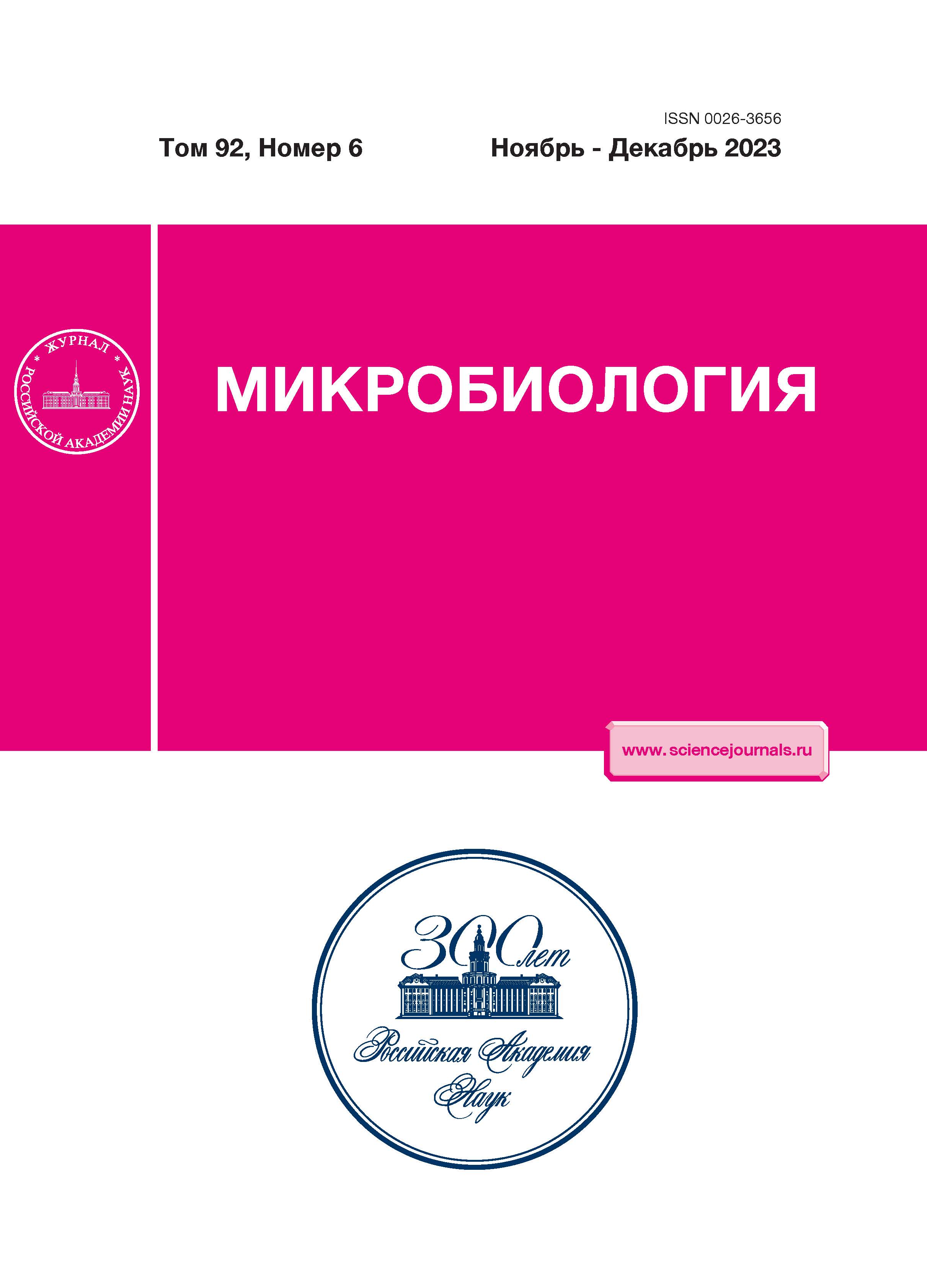Effect of the Extracts from Lichens and Lichenophilic Fungi on in vitro Growth of Clinically Significant Microorganisms
- Authors: Pankratov T.A.1, Shcherbatov R.E.2, Del’tsov A.A.2
-
Affiliations:
- Winogradsky Institute of Microbiology, Federal Research Center of Biotechnology, Russian Academy of Sciences
- Skryabin Moscow State Academy of Veterinary Medicine and Biotechnology
- Issue: Vol 92, No 6 (2023)
- Pages: 609-616
- Section: EXPERIMENTAL ARTICLES
- URL: https://jdigitaldiagnostics.com/0026-3656/article/view/654997
- DOI: https://doi.org/10.31857/S002636562360027X
- EDN: https://elibrary.ru/BPNRES
- ID: 654997
Cite item
Abstract
Abstract—
Activity of the ethanol extracts from lichens (LE), of the cultures of lichenophilic (endobiotic) fungi (LFE), and of ethanol extracts from these cultures was tested using the following test organisms: Escherichia coli, Salmonella typhimurium, Pseudomonas fluorescens, Staphylococcus aureus, Micrococcus luteus, Enterococcus faecium, Paenibacillus sp., and Candida parapsilosis. Selective activity of LE and LFE against yeasts and gram-positive and gram-negative bacteria was revealed. The extracts from Cladonia rangiferina exhibited no activity against any of the tested cultures. The previously reported locus effect on activity of metabolites of one lichen species was confirmed. Agar block technique was used to detect selective activity of 23 out of 61 analyzed fungal strains against gram-positive and gram-negative bacteria, and of 8 strains, against yeasts. Ethanol extracts of six cultures were shown to suppress growth of St. aureus, M. luteus, Paenibacillus sp., and E. coli. Strain NM10F28209 from the lichen Stereocaulon paschale, which exhibited inhibitory activity against Ca. parapsilosis was selected for priority development of an antifungal preparation.
Keywords
About the authors
T. A. Pankratov
Winogradsky Institute of Microbiology, Federal Research Center of Biotechnology, Russian Academy of Sciences
Author for correspondence.
Email: tpankratov@gmail.com
Russia, 119071, Moscow
R. E. Shcherbatov
Skryabin Moscow State Academy of Veterinary Medicine and Biotechnology
Email: tpankratov@gmail.com
Russia, 109472, Moscow
A. A. Del’tsov
Skryabin Moscow State Academy of Veterinary Medicine and Biotechnology
Email: tpankratov@gmail.com
Russia, 109472, Moscow
References
- Демьянкова М.В., Садыкова В.С., Глухова А.А., Ефименко Т.А., Бойкова Ю.В., Малкина Н.Д., Кормилицина В.Г., Шарапченко С.О., Сумарукова И.Г., Васильева Б.Ф., Иванкова Т.Д., Терехова Л.П., Габриелян Н.И., Ефременкова О.В. Подход к поиску продуцентов антибиотиков, преодолевающих лекарственную устойчивость микроорганизмов // Антибиотики и химиотерапия. 2021. Т. 66. № 7–8. С. 4–12.https://doi.org/10.37489/0235-2990-2021-66-7-8-4-12
- Егоров Н.С. Микробы антагонисты и биологические методы определения антибиотической активности. М.: Высшая школа, 1965. 212 с.
- Ершова Е.Ю., Тихонова О.В., Лурье Л.М., Ефременкова О.В., Комзолкина О.В., Дудник Ю.В. Антимикробная активность штаммов Laetiporus sulphurеus в условиях глубинного культивирования // Антибиотики и химиотерапия. 2003. Т. 48. № 1. С. 18–22.
- Ефименко Т.А., Ефременкова О.В., Сумароукова И.Г., Васильева Б.Ф., Демкина Е.В., Эль-Регистан Г.И., Петрова М.А. Бактерии, выделенные из вечной мерзлоты Антарктики – эффективные продуценты антибиотиков // Микробиология. 2018. Т. 87. С. 573‒580.https://doi.org/10.1134/S0026365618050087
- Efimenko T.A., Efremenkova O.V., Sumarukova I.G., Vasilyeva B.F., Demkina E.V., El’-Registan G.I., Petrova M.A. Bacteria isolated from Antarctic permafrost are efficient antibiotic producers // Microbiology (Moscow). 2018. V. 87 P. 692–698.https://doi.org/10.1134/S0026261718050089
- Качалкин А.В., Глушакова А.М., Панкратов Т.А. Дрожжевое население лишайников полуострова Киндо // Микробиология. 2017. Т. 86. С. 762‒769.https://doi.org/10.7868/S0026365617060076
- Kachalkin A.V., Glushakova A.M., Pankratov T.A. Yeast population of the Kindo peninsula lichens // Microbiology (Moscow). 2017. T. 86. C. 786–792. https://doi.org/10.1134/S0026261717060078
- Корчиков Е.С., Зеленская Е.А., Халикова Л.В., Турченко П.С. Влияние экологических условий на накопление вторичных метаболитов лишайников рода Cladonia и семейства Parmeliaceae // Самарский научный вестник. 2021. Т. 10. № 3. С. 58–63.https://doi.org/10.17816/snv2021103108
- Определитель лишайников России. Вып. 6. Алекториевые, Пармелиевые, Стереокаулоновые. СПб., 1996. 203 с.
- Цуриков А.Г., Корчиков Е.С. Определитель лишайников Самарской области. Ч. 1. Листоватые, кустистые и слизистые виды: учеб. пособие. Самара: Изд-во Самарского ун-та, 2018. 128 с.
- Antimicrobial Resistance Collaborators. Global burden of bacterial antimicrobial resistance in 2019: a systematic analysis // Lancet. 2022. V. 399 (10325). P. 629‒655.https://doi.org/10.1016/S0140-6736(21)02724-0
- Huneck S., Yoshimura I. Identification of lichen substances. Berlin, Heidelberg: Springer, 2012. 493 p.
- Kosanić M., Ristić S., Stanojković T., Manojlović N., Ranković B. Extracts of five Cladonia lichens as sources of biologically active compounds // Farmacia. 2018. V. 66. P. 644–651.https://doi.org/10.31925/farmacia.2018.4.13
- de Kraker M.E., Stewardson A.J., Harbarth S. Will 10 million people die a year due to antimicrobial resistance by 2050? // PLoS Med. 2016. V. 13. Art. e1002184.https://doi.org/10.1371/journal.pmed.1002184
- Molnára K., Farkas E. Current results on biological activities of lichen secondary metabolites: a review // Z. Naturforsch. C J. Biosci. 2010. V. 65. P. 157–173.https://doi.org/10.1515/znc-2010-3-401
- Nikolaev Y.A., Tutel’yan A.V., Loiko N.G., Buck J., Sidorenko S.V., Lazareva I., Gostev V., Manzen’yuk O.Y., Shemyakin I.G., Abramovich R.A., Huwyler J., El’-Registan G.I. The use of 4-hexylresorcinol as antibiotic adjuvant // PLoS One. 2020. V. 15. Art. e0239147.https://doi.org/10.1371/journal.pone.0239147
- Noh H.-J., Lee Y.M., Park C.H., Lee H.K., Cho J.-C., Hong S.G. Microbiome in Cladonia squamosa is vertically stratified according to microclimatic conditions // Front. Microbiol. 2020. V. 11. Art. 268.https://doi.org/10.3389/fmicb.2020.00268
- Noh J.-I., Mun S.-K., Lim E.H., Kim H., Chang D.-J., Hur J.-S., Yee S.-T. Induction of apoptosis in MDA-MB-231 cells treated with the methanol extract of lichen Physconia hokkaidensis // J. Fungi. 2021a. V. 7. Art. 188.https://doi.org/10.3390/jof7030188
- Noh H.-J., Park Y., Hong S.G., Lee Y.M. Diversity and physiological characteristics of Antarctic lichens-associated bacteria // Microorganisms. 2021b. V. 9. Art. 607. Doi: https://doi.org/10.3390/microorganisms9030607
- Oh J.M., Kim Y.J., Gang H.S., Han J., Ha H.H., Kim H. Antimicrobial activity of divaricatic acid isolated from the lichen Evernia mesomorpha against methicillin-resistant Staphylococcus aureus // Molecules. 2018. V. 23. Art. 3068. https://doi.org/10.3390/molecules23123068
- Silva D.P.D., Cardoso M.S., Macedo A.J. Endophytic fungi as a source of antibacterial compounds – a focus on gram-negative bacteria // Antibiotics. 2022. V. 11. Art. 1509.https://doi.org/10.3390/antibiotics11111509
- Shrestha G., Raphael J., Leavitt S.D., Clair L.L.St. In vitro evaluation of the antibacterial activity of extracts from 34 species of North American lichens // Pharm. Biol. 2014. V. 52. P. 1262‒1266.https://doi.org/10.3109/13880209.2014.889175
- Xu M., Heidmarsson S., Olafsdottir E.S., Buonfiglio R., Kogej T., Omarsdottir S. Secondary metabolites from cetrarioid lichens: chemotaxonomy, biological activities and pharmaceutical potential // Phytomedicine. 2016. V. 23. P. 441–459.https://doi.org/10.1016/j.phymed.2016.02.012
Supplementary files










